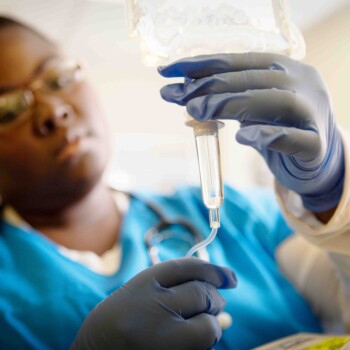Article Summary
The history of IV nutrition dates back centuries, marked by experimentation and eventual clinical application. Despite its origins, modern IV therapy remains popular and continually evolves, driven by patient and physician interest, although formal clinical data remains limited.Modern-day intravenous (IV) nutrition has an interesting history founded in wild experimentation, survival and necessary supplementation. IV and injectable nutrition therapies remain a popular wellness treatment that both patients and physicians regularly inquire about. Despite sporadic, informal and superficial clinical data, common IV nutrition protocols continue to evolve as part of a group of wellness-related medical treatments that remain in high demand. In fact, infusing or injecting specific micronutrients or nutritional solutions is not a new therapy. Parenteral nutrition use goes back to the early 20th century, while the basic IV administration of fluids and electrolytes began in the 1800s, and the foundations for this therapeutic area go back hundreds of years.
William Harvey and the Discovery of Blood Circulation
The first milestone in this field was the discovery of general blood circulation by William Harvey in 1628. His description became the anatomical basis for intravenous infusion. Many investigations were performed during the following centuries, showing that solutions containing electrolytes and glucose could be given intravenously in humans. There were a variety of attempts at using intravenous therapies to treat different conditions. Unfortunately, many patients ended up being guinea pigs in experiments that led to illness or death.
The period of experimentation following William Harvey’s discovery resulted in a variety of dangerous ingredients people attempted to administer intravenously, including the blood from different animals to increase their vitality or libido, or to cure disease. This was prior to understanding the importance of sterility, blood typing and other important considerations. Many of these therapies were based on limited scientific knowledge and strongly held religious beliefs common in the time. For example, there are recorded stories of people who attempted IV infusion of lamb’s blood to promote longevity, reportedly based on the biblical references comparing Jesus to a lamb. Unfortunately, many patients died during or after treatment. However, these experiments paved the way for what we know today about this route of administering food and drugs.
William O’Shaughnessy and the Beginnings of IV Nutrition
Another important milestone occurred during the 1830s. There was a cholera outbreak in England in 1831, and many people died because there was no available treatment for the disease. Around that time, a young Irish physician named William O’Shaughnessy pursued an interest in studying cholera as he witnessed so many people dying from it. He traveled to Europe and, using his knowledge of chemistry, examined the blood and stool of his cholera patients. He made crude measurements of the electrolytes in both specimens and determined that the patients were severely dehydrated. To treat the dehydration, Dr. O’Shaughnessy developed a hypotonic IV solution that resulted in improved survival for the patients who received it. That might be the first recorded clinical implementation of IV nutrition.
IV Therapy and Total Parenteral Nutrition in the 20th Century
A major step toward a better understanding of parenteral nutrition occurred during the early 20th century, when infusions of glucose, plasma and emulsified fat into humans became possible.
During the 1930s and ‘40s, a clinical surgery professor at Washington University named Dr. Robert Elman observed that amino acids can be intravenously infused when delivered in the form of protein hydrolysates, peptides and isolated amino acids. Prior to this, our knowledge of amino acid metabolism accumulated over time. Our understanding of the effects specific amino acids and proteins in humans began to accelerate with Elman’s discoveries, along with the work of many others researching protein metabolism in previous years. In 1948, Elman concluded that the “use of parenteral amino acid mixtures enables the physician to treat disease without protein starvation.”
By the late 1940s, the availability of vitamins and advances in technology resulted in stable vitamin solutions for injection and IV administration. This allowed doctors to treat vitamin deficiencies, and the diseases that caused or were caused by the deficiencies, with supplementation that was now available in multiple dosage forms, including injection.
At this point, the framework was established for the introduction of a complete nutritional therapy consisting of the necessary vitamins, minerals, proteins, fats and glucose. Accumulated discoveries spanning across decades finally started to deliver nutritional products as newly found methods allowed us to isolate specific micronutrients and then synthesize them into pharmaceutical products that included sterile solutions meant for intravenous infusion.
The concept of taking in food intravenously began to evolve between the 1950s and ‘60s. Until that time, IV nutrition was limited to specific vitamins, minerals, glucose and fluids, but there was still nothing available that could replace food entirely in patients who were unable or prohibited from eating food or drinking fluid by mouth.
During the 1950s, physicians were aware of the negative effects of starvation or malnourishment on patient mortality and recovery. However, there was still not enough understanding of the correlation between adequate nutritional support in patients and positive clinical outcomes. Feeding patients who were unable to eat remained a major problem to solve. During this time, it was thought that it was impossible to intravenously administer a complete nutrition formula containing all nutritional necessities in the form of macronutrients and micronutrients.
The status of IV nutrition support changed in the 1960s, however, following the development of an effective total nutrition solution that could be administered intravenously. Stanley Dudrick and Douglas Wilmore, surgeons and researchers at the University of Pennsylvania, completed the first investigation on beagle puppies. They continued testing IV nutrition on adult patients malnourished from a variety of surgical complications and gastrointestinal conditions. After that, a human infant was successfully fed intravenously, which then resulted in widespread clinical application of total parenteral nutrition (TPN).
Today, 80% of hospitalized patients receive IV therapy. A large percentage of medications are now administered by intravenously. IV therapy is becoming more widely used in extended-care facilities and home-care situations. The IV formulations used in popular IV clinics are prescribed for nutritional supplementation, however, not for TPN survival. Nutritional supplementation is used to treat a specific condition or to provide an outcome. TPN solutions are designed to provide all the nourishment needed for survival and are given to patients who cannot eat on their own. TPN is not possible without first understanding the effects of micronutrients and being able to produce them as stable solutions for injection.
John Myers and the Emergence of Contemporary IV Therapy
Popular, modern-day IV nutrition therapy may have started with a Johns Hopkins internal medicine doctor named John Myers. Dr. Myers was a practicing medical doctor from the 1940s through the ‘70s. Prior to becoming a physician, though, he was an electrical engineer. His training in that field provided him foundational interest in the interrelationships of the biochemistry that fuels cellular function as well as the application of nutritional elements to improve metabolic function.
Dr. Myers recognized that we have substances including minerals (elements) in our body and that careful manipulation of this chemistry can sometimes influence positive outcomes. He did this through experimenting with micro-nutritional supplementation and was particularly fascinated with elements and vitamins.
His position at Johns Hopkins allowed him to treat chronically ill patients who needed ongoing management or those with an unknown diagnosis. Part of his integrative treatment plans included IV infusion of elements and vitamins in different combinations. He would often see patients whom no one else could diagnose, including those suffering from chronic conditions like fatigue, depression, cough and allergies that were unresponsive to treatment. He gave these patients different IV formulas while observing and recording the outcomes.
He was one of the first doctors to record benefits and positive outcomes when administering these nutrient infusions. He captured these outcomes and reported the improvement the patients experienced when given a high-dose fluid containing minerals and vitamins.
Alan Gaby and the Myers’ Cocktail
Dr. Myers’ findings were lost to time, however, until they reemerged in the early 2000s when a physician named Alan Gaby published a book called Nutritional Medicine. He dedicated a chapter to the “Myers’ cocktail” with mention of Dr. Myers’ research and protocols.
This publication resulted in the popularity of the Myers’ cocktail spreading across the U.S. Dr. Myers’ exact formula is unknown, possibly since he changed it depending on the patient’s condition, but Dr. Gaby was able to identify the common foundational ingredients used in the original Myers’ cocktail. The ingredients include calcium, magnesium, ascorbic acid (vitamin C), vitamin B complex and trace minerals at various levels, depending on the patient.
Almost all modern IV infusion clinics offer a modified version of the Myers’ cocktail. However, many of the ingredients used in IV nutrition formulas today can only be sourced from an outsourcing facility that specializes in sterile solutions.
Modern IV nutrition continues to increase in popularity and demand today. There is not yet enough financial incentive for big research around the effects of these therapies, but hopefully, the continued development and feedback of IV nutrition protocols among practicing physicians will contribute to our understanding of the effects nutritional supplementation can have on clinical outcomes and quality of life in patients.
Clinic Resources
Online IV Nutrition Training
- A4M offers an IV therapy symposium along with other integrative medicine courses
- The American Academy of Environmental Medicine (AAEM) offers IV therapy training
Chelation Training
Chelation therapy can have some risks that are greatly reduced if the clinician is properly informed and trained. The American College for Advancement in Medicine (ACAM) offers a training course for chelation therapy that culminates in certification.
Recommended Reading
- Nutritional Medicine, by Alan R. Gaby, M.D.
- The Definitive Guide for Intravenous Therapy With Nutrients (revised 2015), by W.A. Shrader Jr., M.D.
- The Science and Art of Parenteral Clinical Nutrition, by Mitchell J. Ghen, D.O., Ph.D., and Nayan Patel, Pharm.D.
- Dudrick SJ. Early developments and clinical applications of total parenteral nutrition. JPEN J Parenter Enteral Nutr. 2003;27(4):291-299.
- Elman R. Amino acid mixtures as parenteral protein food. Am J Med. 1948;5(5):760-774. doi:10.1016/0002-9343(48)90153-3
- Gaby, AR. Nutritional Medicine. Fritz Perlberg; 2011.
- Moon, JB. Sir William Brooke O’Shaughnessy — The foundations of fluid therapy and the Indian Telegraph Service. N Engl J Med. 1967;276(5):283-284. doi:10.1056/NEJM196702022760509
- Nakayama DK. The development of total parenteral nutrition. Am Surg. 2017;83(1):36-38.
- Shils ME. Historical aspects of minerals and vitamins in parenteral nutrition. Fed Proc. 1984;43(5):1412-1416.
- Shutte, KH, Myers, JA. Metabolic Aspects of Health: Nutritional Elements in Health and Disease. Discover; 1979.
- Wretlind A, Szczygieł B. Całkowite zywienie pozajelitowe. Historia. Teraźniejszość. Przyszłość [Total parenteral nutrition. History. Present time. Future. Pol Merkur Lekarski. 1998;4(22):181-185.




